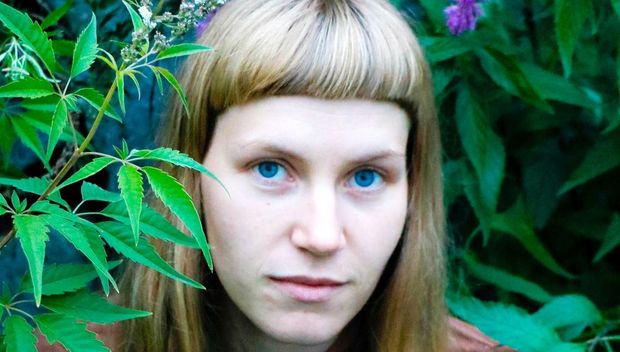Fashion and bacteria? They actually go hand-in-hand! Discover the "Growing Colors" project and learn more about an unusual and new world of color!

Bacterial pigment can be used to dye textiles and create a variety of colors, shapes and patterns. "Growing Colors" is a project that focuses on the presence of bacteria in our natural environment and making these colors more visible to the naked eye. By combining this resource-saving and environmentally friendly dyeing method with new technologies, we open up completely new avenues to not only make the world more colorful - bluer, more yellow, and more red - but also just a bit "greener" and thereby more sustainable.
Can you briefly describe your project?
Julia Moser: We can’t always rely on our senses to detect bacterial properties. Our project focuses on hidden bacterial pigments in our immediate environment and making them more visible. Part of our project is collecting diverse bacterial pigment bacteria from the area at the JKU and then exhibiting these pigments at the spot where they were discovered. In addition to other bacterial strains in databases, we aim to show there is potential to dye textiles using bacterial pigments and not only make the world more colorful - bluer, more yellow and more red - but also a bit "greener" and ultimately more sustainable. We can do this because this particular dyeing method doesn’t require using much water and doesn’t need any harmful chemicals.
Where did the idea or inspiration come from?
Julia Moser: Our project aims to shine a light on the way the textile industry often heavily pollutes the environment. While they use partly natural dyes, they mostly use chemical dyes. Dyes made from bacterial pigments give us an opportunity to move away from harmful chemicals and save resources. We would like to make this method of dyeing more competitive with other dyeing methods and inspire new ideas. In addition, we want to show just how beautiful bacteria is, boost its image, help people to not be so afraid of the idea, and bring the hidden colors in our environment to light.
Who are the project team members?
Julia Moser: Our core project team is made up of employees in the fields of chemistry, polymer sciences, microbiology, and textile/fashion. While using bacterial pigments as a dye falls into the field of microbiology, combining dye and fiber requires expertise in chemistry. Treating various surface structured fabrics using different agents and substrates requires skills and additional research by experts at the Institute of Polymer Sciences. At the same time, however, textile and design also play a crucial role. To plan our exhibition, we also have the support of project partners such as bacteriographer Erich Schopf (Vienna Textile Lab), the Textile Center in Haslach, and budding architects.
What does "A New Digital Deal" mean when it comes to your project; or, what would you like to see as part of a "New Digital Deal"?
Julia Moser: "The ‘deal’ comes from sharing"; this quote by the ARS Electronica in regard to "A New Digital Deal" resonates strongly with me and this is basically what I want to see. In our case, it means coming together - across disciplines - to work toward a larger purpose and create the future as we see it. Moving forward doesn't help anyone if we always start from scratch. It's about embracing an open-source mindset and finding ways to make sustainable methods more competitive and replace other, less environmentally-friendly methods. It's also all about collaboration, shifting the way we think, flexibility, and moving away from familiar structures.
What can visitors look forward to most when they come to see your project?
Julia Moser: Visitors can look forward to seeing colors that are normally invisible to the naked eye - colors we are surrounded by every day. Bacterial pigments are everywhere but we can only see them under certain conditions. We aim to create the ideal conditions to expose these colors and show all of the diverse results when we combine different bacterial pigment with various fibers and fabric treatment.
What have been some of the greatest challenges when implementing your project? What was the biggest surprise?
Julia Moser: The toughest challenge was working with living organisms and having to meet a deadline. These organisms have a real life of their own and they don’t really care for time constraints. The pandemic affected crucial deliveries and that didn’t help either. The great part, though, was collaborating with others and growing our team! There were more minds able to think in different directions and visitors will be impressed with the results!
Learn more about the JKU projects at the 2021 Ars Electronica Festival








